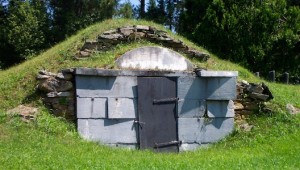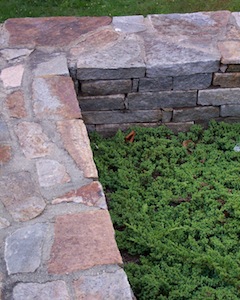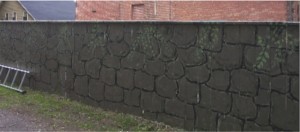
In popular speech, stone walls are easy to recognize but difficult to define. Much the same has also been said about pornography. As we move toward studying them scientifically and managing them as a specific category of cultural resource, it is increasingly important that we develop an unambiguous definition that will stand up to scientific and legal scrutiny, and one that government agencies can easily use.
Consider, for example, the phrases ” wetland soil” or “endangered species.” Given the financial impact and regulatory importance of these words, exact definitions are required. Otherwise where does a wetland end and a non-wetland begin? What separates endangered from non-endangered? Likewise, where does a stone wall begin and a non-stand wall end? What separates a rubble wall from a pile? How can either be differentiated from the background stoniness of many New England soils?

In this taxonomy, a stone wall is one of four easily identified classes of stone objects within the stone domain, as defined below in technical language.
This comes from the scholarly, peer-reviewed mini-monograph published in the journal Historical Archaeology in September, 2023 under the title “Taxonomy and Nomenclature for the Stone Domain in New England.”
In technical language, and after countless solicited conversations with masons, landowners, field trip participants, and archaeologists, I’ve come to a definition that works for me until a better one comes along. It is a culturally created object that is discrete from its surroundings, composed of stone, composed of particles (or grains) rather than a single cut piece of rock, more than four times longer than it is wide, continuous along its length, and, in the vertical dimension, the stones either rest above one another or about two feet high.
- “Culturally created” means either created by humans or, if originally natural, shaped and adapted for cultural use. This term excludes “natural” stone walls, for example a volcanic dike or low hogback ridge standing above less resistant adjacent material.
- “Discrete” means clearly differentiated from the ambient terrain, morphologically a signal above the noise.
- “Composed of stone,” means any kind of stone. I use the term “stone” rather than “rock” for material because it is more inclusive in the mind of readers. Rock is a material aggregate of one or more minerals, whereas stone is an object composed of rock. Synthetic stone is included because there exists a complete continuum between porcelain-quality ceramic bricks, and artificial stone, made to look like the real thing. Besides, many roadside walls contain fragments of broken up brick, bituminous pavement and/or concrete. Finally, natural puddingstone (sedimentary conglomerate) and concrete often closely resemble each other.
- “Continuous” means that the form is continuous along the line, without notable gaps. Abutting boulders qualify, provided the space between them is minimized.

Quoting the Taxonomy:
The length, width, and heigh dimensions in XYZ space are critical to the definition. They are based on empirical, albeit anecdotal evidence drawn from two sources: a review of the historic literature, for example the word “wall” used next to an old photograph; and from countless field interviews with surveyors, masons, historians, and mappers during which I asked the question: “Is this a wall?”
- Note that there is no minimum length or maximum width. What’s important is the length-to-width ratio. The functional threshold that best differentiates walls from non-walls is 4:1.
- Finally, there is the vertical height. There must be EITHER stones place one above another, or an arbitrary minimum height. See details in the paragraph below.

Many of the linear stone features in New England that the vast majority of observers consider to be stone walls are actually little more than a low row of stones stacked above one another, many not more than a foot above the ground. Yet culturally, they are stone walls, even if they were originally little more than sprawling long piles of stone along a former fence line. Yet the same observers would exclude row of small boulders bordering a driveway or a garden as being a wall. The difference is whether the stones were placed one above the other. Hence, to meet the vertical requirement a wall can be of any height, provided the stones are placed one above the other. This criteria does not apply to large stones abutting either other to form a continuous barrier meeting the other criteria (cultural, discrete, stone, continuous). For such walls, a minimum height is required to differentiate them from the class stone rows. Based on the historic literature and field interviews, ankle-high is too low, and knee-high is too high. If you insist on a vertical threshold, 1.5 feet seems to work best.
